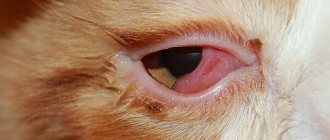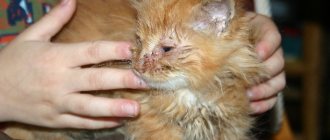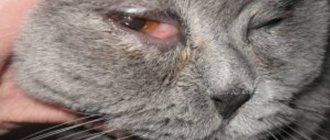Conjunctivitis is an inflammation of the mucous membrane that lines the inner surface of the eyelids and protects the eyeball. This is one of the most common eye diseases in cats of all ages. Both adult animals and kittens in the first weeks of life are susceptible to it. Conjunctivitis only in a limited number of cases develops as an independent disease and most often is one of the symptoms of other health disorders.
The cat owner should be responsible for the signs of inflammation of the conjunctiva in their pet in order to take timely measures and prevent complications.
Common signs of eye disease in cats
Since cats actively communicate with their owner, establishing visual contact with him, an attentive owner will easily notice the beginning of a pathological process in the eyes of his pet.
The first warning sign will be excessive lacrimation. In the morning, a large accumulation of mucus appears in the corners of the cat's eyes.
Sometimes there is so much discharge that it leaves behind brown tear tracks that stretch up to the chin.
As the disease progresses, the mucus becomes thicker and acquires a greenish-yellow tint. In advanced cases, it dries out, the eyelids stick together, and the resulting crusts completely deprive the cat of vision. The animal experiences severe itching; it rubs its muzzle on the carpet and upholstered furniture, trying to alleviate its condition.
The owner should be alerted to any redness of the eyeball or skin on the eyelids. Most often this is accompanied by frequent blinking or squinting of the cat. Of particular concern to the animal is the swelling that develops in the skin around the eyes. In such situations, the pet hides from the light in the dark corners of the apartment and reacts sharply to any touch on the head.
Sudden strabismus may indicate the onset of cataract development. This is a chronic pathology that is typical for older animals. However, now more and more young cats are losing their sight for this reason.
Keratoconjunctivitis
A disease caused by an adenovirus that affects the conjunctiva and cornea.
Transmitted by contact.
From the moment of infection to the onset of the disease, 7-8 days pass. It begins with headache, chills, weakness and apathy. Then there is pain in the eyes and redness of the sclera, a feeling of a foreign body inside and profuse lacrimation with mucus discharge from the lacrimal canal.
The conjunctiva turns red, small bubbles with liquid inside appear on it - a characteristic manifestation of an adenoviral infection.
With timely treatment, after 5-7 days, signs of infection disappear, with the exception of photophobia. Cloudy lesions form in the cornea. Complete healing occurs after two months.
When you need urgent veterinary help
Immediate contact with a veterinarian is required in cases where the pupil or cornea of the eye has changed color, shape, size, or the eyeball has hardened. In addition, you should not delay your trip to the clinic if your cat has severe pain in the eye area.
This is not difficult to understand: the pet reacts to even a light touch with a loud meow, hides from the owner, and shows aggression to any attempt to pick itself up.
Such conditions indicate severe ophthalmological pathology and require urgent assistance from a specialist.
Types of diseases and their treatment
Visible clinical signs do not always allow an accurate diagnosis to be made at home, since there can be many causes of eye disease with the same symptoms. Effective treatment requires consultation with a veterinarian with some diagnostic measures.
Conjunctivitis
Conjunctivitis is one of the most common ophthalmic diseases in pets. It is expressed in acute inflammation of the conjunctiva - the thin mucous membrane lining the eyeball and the inner surface of the eyelids.
The main symptoms of conjunctivitis:
- lacrimation;
- swelling, hyperemia of the eyelids;
- photophobia;
- change in the shade of the “iris”, its cloudiness;
- eversion of the eyelid;
- discoordination of pupil movements.
Conjunctivitis begins to develop from the catarrhal stage, at which the eyes become red, swollen, and abundant clear tears are released. The body temperature remains normal, however, if the disease has become a complication of a cold, the cat may become febrile.
Conjunctivitis in animals | Causes of conjunctivitis | Symptoms and treatment of the disease | Veterinarian Advice
At the next stage, the discharge becomes purulent in nature. After a long sleep, the eyes become covered with yellow-green crusts, which indicate the need for urgent treatment. In its absence, the cat develops keratitis, panophthalmitis, and blindness.
Purulent conjunctivitis can turn into phlegmonous, when pus penetrates not only outside, but also into the inner subepithelial layer of the eye mucosa. This requires complex long-term therapy and constant attention from the owner.
If the disease takes on a follicular form, it means that the inflammatory process has affected the lymphatic follicles in the third eyelid. The pathology is chronic, and treatment is often associated with surgery.
Keratitis
Keratitis is an inflammation of the cornea.
It develops due to the following reasons:
- mechanical damage;
- complication of conjunctivitis, calicivirus, adenovirus, herpes;
- thermal or chemical burn of the eyes;
- allergy;
- autoimmune processes;
- breed characteristics;
- vitamin deficiency.
The most striking symptoms of keratitis are:
- clouding of the cornea and a rough appearance of its surface;
- speckling of the cornea with blood vessels;
- swelling of the eye due to the accumulation of fluid inside the cornea;
- lacrimation;
- scar formation, blindness;
- severe photophobia.
To relieve symptoms and alleviate the animal’s condition, hormonal and antimicrobial drugs are used. However, if the cause of the pathology is not eliminated, keratitis can become chronic with frequent relapses.
Third eyelid
Every cat has a third eyelid. This is a crescent-shaped fold of the conjunctiva that protects the eye from infections and injuries during hunting, distributes tear fluid, and collects dust and other small particles from the eyeball. Normally, the third eyelid in cats only protrudes slightly from the inner corner of the eye, but for some reasons it can fall out, causing considerable discomfort to the animal.
This condition is not an independent disease, but a symptom of other pathologies, including:
- gastrointestinal diseases;
- dehydration;
- chronic renal failure;
- parasitic diseases;
- allergic conjunctivitis;
- eye injuries;
- viral infections;
- third eyelid adenoma;
- prolapse caused by breed (“British”, “Persians”, “Scottish”, etc.).
The third eyelid of a cat. Acute keratitis. Herpes virus infection. Treatment
The symptoms of the disease are:
- complete or partial closure of the eye with film;
- frequent blinking, photophobia;
- excessive lacrimation, redness of the eyes;
- constriction of the pupil, drooping eyelid;
- the formation of a creeping ulcer.
Treatment for third eyelid prolapse can be conservative (with medication) or surgical.
Blepharitis
Blepharitis is a dangerous disease that can lead to complete blindness. It is expressed in acute inflammation of the marginal surface of the eyelid.
The most common reasons are:
- demodicosis;
- blockage of the sebaceous glands;
- endocrine disorders;
- autoimmune diseases.
Blepharitis is often accompanied by redness, swelling of the eyelids, and profuse lacrimation. Discharge from the eyes may be purulent. The cat has severe itching, which she tries to relieve by constantly scratching with her paw or against furniture.
As inflammation develops, the eye shape gradually decreases and the viewing angle narrows. With fungal blepharitis, eyelashes fall out and bald spots appear on the body. In the autoimmune form of the disease, blisters with clear liquid may swell on the skin, which must be regularly treated with special solutions. If the cause of the disease is an infection, the cat will experience fever, depression, lethargy, and apathy.
The treatment regimen for blepharitis includes medications to eliminate the cause of the disease and relieve symptoms. In most cases, it is possible to manage with conservative methods, but in advanced situations, surgical intervention may be required.
Panophthalmitis
Panophthalmitis is an acute purulent inflammation of all membranes and tissues of the eye. According to veterinarians, this is the most severe complication of perforated eyeball injuries in cats.
The process of disease development is as follows:
- Due to external reasons, the animal injures the eye. The objects of injury can be metal, stone, nail, wire, dirty wood.
- Through the wound canal, infections enter the eye: pneumococcus, staphylococcus, streptococcus, Pseudomonas aeruginosa and Escherichia coli.
- Pathogenic microflora of the conjunctival sac is associated with intraocular infection.
- 2-4 days after injury, the first signs of the disease appear. Symptoms are rapidly increasing.
The main signs of the disease are:
- sharp pain in the eye area;
- lacrimation;
- photophobia;
- uncontrolled closing of the eyelids;
- swelling and hyperemia of the eyelids;
- pinching of the eye by the eyelids.
The pus quickly destroys the “iris”, and the eye hurts. With bilateral damage, the animal becomes completely blind. Most often, treatment for panophthalmitis involves surgical removal of the diseased eye.
Cataract
Cataract is an eye pathology in which the lens becomes cloudy, visual acuity decreases until complete blindness.
The causes of the disease are:
- old age of the cat;
- injury;
- metabolic disorders;
- inflammatory eye diseases.
Cataracts are often hereditary or congenital.
In the initial stages, the development of the disease can be stopped using conservative methods. First of all, they are aimed at restoring metabolic processes inside the crystal. However, medications are not able to restore an already clouded pupil.
A radical and effective method of treating cataracts is surgery, during which the doctor replaces the affected lens with an artificial lens. After this, the cat’s vision is fully restored.
Viral conjunctivitis
The cause of the disease is the introduction of a viral agent. There are several forms of the disease, with a specific nature of the pathological process.
Herpetic conjunctivitis is typical for young children. The inflammatory process spreads beyond the mucous membrane into the surrounding tissues. It can be catarrhal, follicular and vesicular-ulcerative.
The most severe form of the disease is vesicular ulcerative. It is manifested by the appearance of small transparent bubbles with liquid on the mucous membrane of the eye. They are characterized by spontaneous opening with the formation of painful ulcers, which causes lacrimation and photophobia in patients.
After 5-7 days, the symptoms of the disease disappear spontaneously without additional therapy. Visual acuity does not change, no traces remain on the cornea.
Inflammation of the nasolacrimal ducts
Epiphora is a disease of the nasolacrimal ducts, which is expressed in their blockage and inflammation.
The reasons lie in:
- breed predisposition (Scottish, Persian, exotic cats);
- congenital absence or anatomical narrowness of the neck and mouth of the nasolacrimal ducts;
- injury;
- viral, bacterial, chlamydial infections;
- dacryocystitis;
- canaliculitis.
Inflammation of the nasolacrimal ducts can be diagnosed using a fluorescein test. Before it is performed, the eyes are washed with an antibiotic solution, removing all purulent discharge. Then 1-2 drops of a special composition are instilled into the eye, and the cat’s head is tilted forward. After 2 minutes, the oral cavity of a healthy animal will turn green. If there is partial blockage, coloring will occur within 5-10 minutes. In case of complete obstruction, the natural shade of the mucous membrane will remain unchanged.
Treatment of inflammation of the nasolacrimal ducts is carried out with the help of antibacterial agents, antiseptics and antihistamines. If a cat has a complete blockage of the canals, the veterinarian may resort to surgical bougienage followed by eye hygiene.
Wounds of the eyelids
Wounds to the eyelids are most common in cats that are kept free-range and interact with their cats. Fights for territory and hierarchical fights often end in deep wounds, complicated by infections and street dirt. Untreated wounds in the eye area are accompanied by swelling, hyperemia, and suppuration.
They can be superficial, deep and through. It is enough to clean the superficial wound from dirt and treat it with an antiseptic composition. A deep wound can be recognized by uneven, swollen edges, extensive tissue tears, and copious discharge in the form of ichor or pus. Self-medication of such injuries leads to scar formation and loss of vision.
The veterinarian should examine the patient and determine the extent of tissue damage. Only after this can you choose an effective scheme for restoring cat eyes.
Turn of the century
Entropion (or entropion) is one of the most common ophthalmic diseases in cats. It lies in the abnormal position of the eyelid relative to other structures of the eye.
Entropion can be:
- one-sided or two-sided;
- bottom or top.
The development of pathology is due to the weakness of the connective tissue on the inner lining of the eyelid.
Risk factors include:
- panophthalmitis, uveitis and other inflammations;
- injuries;
- microblepharon (an animal’s inability to close its eyelids tightly, which in winter leads to thermal damage to the cornea);
- corneal syndrome (formation of ulcers on the cornea with copious purulent discharge);
- age-related loss of muscle tone;
- oncological neoplasms.
In the initial stages, the disease manifests itself in frequent blinking, photophobia, and severe pain. As the pathology develops, the discharge becomes cloudy, strabismus appears, the eyelids swell, and the body temperature rises. Transition to the chronic form threatens the cat with complete blindness.
In some cases, conservative treatment is acceptable, but most often doctors recommend surgery.
Glaucoma
Glaucoma is a disease associated with atrophy of the optic nerve and a regular increase in intraocular pressure.
The most common causes of glaucoma are:
- trauma and inflammation of the lens;
- getting particles into the eye;
- chronic purulent inflammation of the eyes;
- changes in the cornea.
The main symptoms of the disease are:
- enlargement and hardening of the eyeball;
- pupil enlargement;
- swelling of the mucous membranes;
- cloudiness and loss of sensitivity of the cornea;
- dark red eye color.
The initial stages of glaucoma are treated with conservative methods using diuretics and antibacterial drugs. When the disease is advanced, cats are operated on.
Dacryocystitis
Inflammation of the lacrimal sac of an infectious nature. Predisposing factors to the disease are the characteristics of the lacrimal canal and fluid stagnation in the lacrimal gland.
The disease is manifested by liquid purulent discharge and lacrimation. A tumor develops in the inner corner of the eye - a swollen lacrimal gland. When pressed, pus flows out of it. Sometimes hydrocele of the lacrimal gland may develop.
Dacryocystitis can be easily cured with timely treatment. Complications often include keratitis and conjunctivitis with a slight decrease in vision.
Treatments
Both special veterinary drugs and medications developed for humans are used to treat cats. Therapy with traditional methods also shows good results.
Medications
Among the medications for the treatment and prevention of ophthalmic drugs in cats, the most effective ones have proven themselves:
- "Bars" - washing for injuries, treatment and prevention of keratitis, conjunctivitis, blepharitis.
- “Iris” - acute and chronic inflammation of the cornea and anterior segment of the eye.
- "Tsiprovet" - therapy and prevention of infectious inflammation of all ocular structures.
- Decta-2 - treatment of allergic and infectious conjunctivitis.
- Lakrikan - hygienic treatment and treatment of inflammatory processes.
- Neoconjunctivitis - treatment of advanced forms of conjunctivitis.
- Sofradex is an antibacterial drug for the treatment of inflammation of the eyes and ears.
ethnoscience
Traditional medicine suggests treating eye pathologies in cats using the following herbs:
- chamomile;
- calendula;
- green tea;
- St. John's wort;
- sage.
All of them have some anti-inflammatory effect and are used for therapeutic and prophylactic treatment of the eyelids and eyeball.
Corneal ulcer
This is an inflammation of the cornea, accompanied by its defect.
Symptoms:
- Squinting (blepharospasm)
- Watery or purulent discharge, pain.
— You may notice a roughness, indentation, or whitish spot on the surface of the cornea.
Treatment:
Depending on the severity of the process:
1. Medication (antibiotics, keratoprotectors, etc.)
2. Surgical.
============================================================================================================================================================================================
Rules for carrying out medical procedures at home
At home, the owner can independently perform ophthalmological procedures.
First of all, this is eye washing, which is carried out in the following way:
- An antiseptic solution, a decoction of a medicinal plant, or special drops are applied to a cotton pad or piece of gauze. With a light and smooth movement from the outer corner of the eye to the inner corner, secretions are removed.
- A napkin generously moistened with an antiseptic is applied to the stuck eyelids of an adult animal or kitten and held for 2-3 minutes. After this, the eyes open randomly, and the softened pus from the fur is removed with the same napkin.
- The eyeball is washed using a syringe without a needle.
- Also, the owner can independently instill a medicinal solution into the lower conjunctival pocket. To do this, he must pull back the cat's lower eyelid, carefully introduce the drug with a pipette, and then close the animal's eyelids. In a similar way, you can put medicinal ointment behind the eyelid.
Barley
The disease is an inflammatory process in the sebaceous gland and ciliary bulbs, caused by staphylococcal and streptococcal infections against a background of weakened general immunity.
It is characterized by redness of the eyelid area, which then turns into infiltration and swelling. Gradually, redness spreads to nearby tissues, swelling of the conjunctiva increases. After 2-3 days, a cavity with pus forms inside the infiltration. On the 3-4th day from the beginning of the process, the purulent sac breaks through with the release of pus beyond the eyelid, pain and swelling subside. In severe cases, the process can spread to surrounding tissues.
By contacting the Moscow Eye Clinic, each patient can be sure that some of the best Russian specialists will be responsible for the results of treatment. The high reputation of the clinic and thousands of grateful patients will certainly add to your confidence in the right choice. The most modern equipment for the diagnosis and treatment of eye diseases and an individual approach to the problems of each patient are a guarantee of high treatment results at the Moscow Eye Clinic. We provide diagnostics and treatment for children over 4 years of age and adults.
Caring for cats with eye diseases
Since ophthalmic problems are often accompanied by severe itching, an Elizabethan collar, which you can purchase at a pet store or make yourself, will help prevent scratching.
To ensure a quick recovery, your cat needs to be provided with comfortable conditions:
- a quiet and darkened room where the pet can sleep peacefully and recuperate;
- light semi-liquid nutrition with the exclusion of all allergenic foods;
- drinking plenty of water;
- attention and care of the owner in moments when the cat itself wants to communicate;
- isolation from other animals if the disease is contagious.
Eye Diseases in Cats - Causes and Treatment // Network of Veterinary Clinics BIO-VET
Choroiditis (posterior uveitis)
This is an inflammatory process behind the choroid. The reason for its occurrence is the introduction of microbes into the capillaries.
The disease is characterized by an initial absence of symptoms. As a rule, choroiditis is discovered incidentally during an ophthalmological examination.
If the focus of inflammation is localized in the center of the choroid, characteristic signs are sometimes observed: distortion of the contours of objects, flickering and light flashes before the eyes.
In the absence of timely antibacterial therapy, retinal edema develops with microscopic hemorrhages.
Prevention measures
Prevention of ophthalmic diseases in cats involves daily eye care. In the morning, the owner must carefully examine the animal and, using a napkin moistened with a special lotion, remove the discharge that has accumulated during the night.
It is better to feed your cat ready-made super-premium food that contains all the necessary nutrients and microelements. This will avoid the development of allergies, which often leads to chronic inflammation of the eyes.
You also need to carefully monitor the cat’s communication with its relatives, if possible, exclude self-walking, and isolate it from aggressive animals that can injure the eyes in a fight.
Do not neglect vaccinating your pet. Annual vaccination protects against many viral diseases that lead to partial or complete loss of vision.
All information posted on the site is provided in accordance with the User Agreement and is not a direct instruction to action. We strongly recommend that before using any product, you must obtain a face-to-face consultation at an accredited veterinary clinic.
Our doctors who will solve your vision problems:
Fomenko Natalia Ivanovna
Chief physician of the clinic, ophthalmologist of the highest category, ophthalmic surgeon. Surgical treatment of cataracts, glaucoma and other eye diseases.
Yakovleva Yulia Valerievna Refractive surgeon, specialist in laser vision correction (LASIK, Femto-LASIK) for myopia, farsightedness and astigmatism.
You can find out the cost of a particular procedure or make an appointment at the Moscow Eye Clinic by calling in Moscow 8 (499) 322-36-36 (daily from 9:00 to 21:00) or using the ONLINE REGISTRATION FORM.











